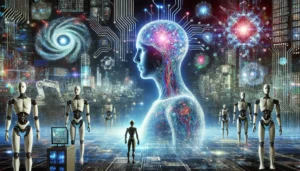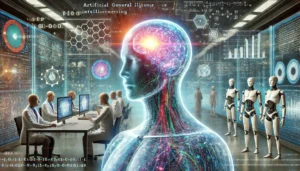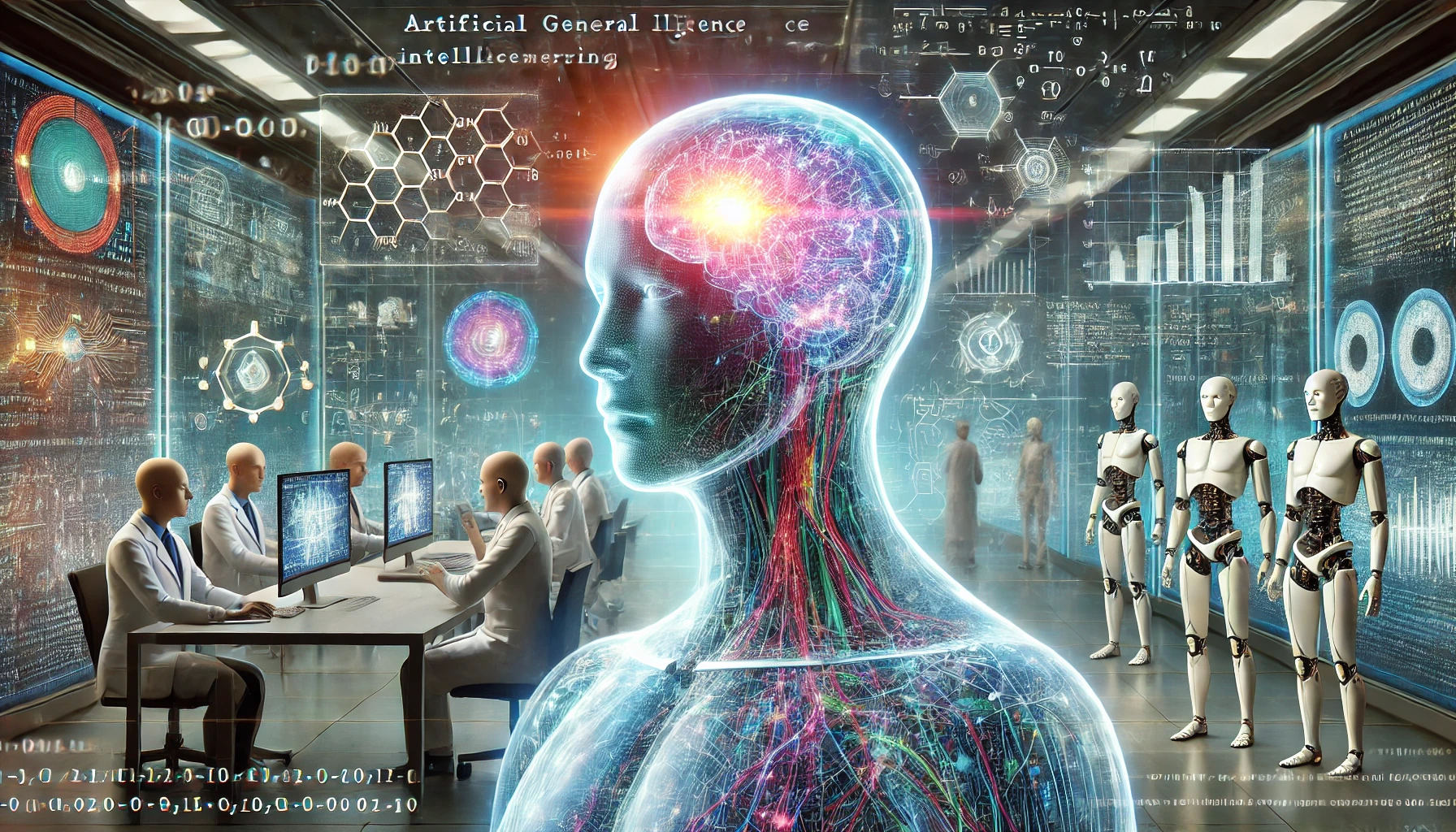
Will AGI replace humans in decision-making?
The Rise of AGI (Artificial General Intelligence): How Close Are We?
Artificial intelligence has made remarkable strides in recent years, from beating humans at complex games to automating tasks once thought impossible for machines. However, these advances remain largely within the realm of narrow AI, systems designed for specific tasks. The real frontier lies in Artificial General Intelligence (AGI)—machines that possess human-like cognitive abilities, capable of reasoning, learning, and adapting across a broad range of activities. But how close are we to achieving AGI, and what are the implications of its emergence?
Understanding AGI
AGI refers to an AI system that can understand, learn, and apply intelligence across various domains, much like a human. Unlike narrow AI, which excels in specific tasks but fails outside its programming, AGI would exhibit flexible problem-solving capabilities. It could independently learn new skills, reason through complex problems, and even exhibit common sense.
An AGI system would be capable of transferring knowledge from one domain to another without explicit reprogramming. This means it could learn new languages, develop strategies, and even adapt its behavior in response to evolving circumstances, much like humans do. The development of AGI would mark a profound shift in AI capabilities, leading to both significant opportunities and potential risks.
The Current State of AI
Despite groundbreaking advancements in machine learning, deep learning, and natural language processing, today’s AI systems still lack true general intelligence. Large language models, such as OpenAI’s GPT series, demonstrate impressive linguistic capabilities but do not truly understand concepts in a human-like way. Similarly, reinforcement learning has enabled AI to master strategic games like Go and chess, yet these systems cannot transfer their knowledge beyond these domains.
Key developments leading toward AGI include:
- Improved Neural Networks: Advances in deep learning architectures and transformer models have enhanced AI’s ability to process information more efficiently.
- Reinforcement Learning: AI systems are increasingly able to learn from their experiences, improving performance over time.
- Self-Supervised Learning: AI models are now capable of learning from vast amounts of unlabeled data, mirroring human learning to some extent.
- Neuroscience-Inspired AI: Research into human cognition is influencing AI design, potentially accelerating AGI development.
- Quantum Computing: The potential integration of quantum computing with AI could exponentially increase computational power, bringing AGI closer to reality.
Table of Contents

Will AGI replace humans in decision-making?
Challenges to Overcome
While progress is steady, several challenges remain before AGI becomes a reality:
- Generalization: AI struggles to generalize knowledge across different domains, a fundamental requirement for AGI.
- Understanding and Common Sense: Machines still lack an inherent understanding of the world and rely heavily on statistical patterns rather than true comprehension.
- Ethical and Safety Concerns: The emergence of AGI raises significant ethical dilemmas, including job displacement, decision-making authority, and potential existential risks.
- Computational Power: The immense processing requirements for AGI-capable systems remain a major hurdle.
- Human Alignment Problem: Ensuring AGI aligns with human values and priorities is a complex challenge that requires careful governance and control mechanisms.
Are We Close to AGI?
Predictions about AGI’s arrival vary widely. Some experts believe it could emerge within decades, while others argue that we are still far from replicating human intelligence. Organizations like OpenAI, DeepMind, and Google are actively pursuing AGI, making incremental breakthroughs that could eventually lead to its realization.
One potential pathway is through hybrid AI systems that combine symbolic reasoning with deep learning, mimicking the way humans think. Additionally, advances in brain-inspired computing, such as neuromorphic chips, could push AI beyond current limitations.
Another critical factor in AGI development is data efficiency. While current AI models rely on vast amounts of data, AGI would need to learn with significantly fewer examples, similar to how humans acquire knowledge. New learning paradigms, such as meta-learning and continual learning, could play a key role in bridging this gap.
The Implications of AGI
The impact of AGI will be profound, influencing virtually every aspect of society. On the positive side, AGI could drive scientific breakthroughs, revolutionize industries, and solve global challenges. It could accelerate progress in medicine, energy, and climate science, offering solutions to some of humanity’s most pressing problems.
However, concerns about control, alignment with human values, and potential misuse loom large. AGI could exacerbate existing societal inequalities, and if not properly managed, could lead to unintended consequences. Issues such as autonomous weapons, privacy violations, and economic displacement due to automation must be carefully addressed. The governance of AGI will require international cooperation, ethical frameworks, and robust regulatory mechanisms to ensure its responsible development and deployment.
Preparing for an AGI Future
Governments, businesses, and researchers must work together to prepare for AGI’s arrival. Proactive measures include:
- Developing Ethical Guidelines: Establishing principles that ensure AGI aligns with human interests.
- Global Collaboration: Encouraging cooperation among nations to prevent misuse and monopolization of AGI technology.
- Investing in AI Safety Research: Prioritizing research in AI alignment, robustness, and security.
- Economic Adaptation: Preparing for workforce changes by investing in education and re-skilling programs.

Will AGI replace humans in decision-making?
Conclusion
While AGI remains an aspirational goal, rapid advancements suggest that it may not be as distant as once thought. The journey toward AGI is filled with challenges, but with continued innovation and ethical foresight, humanity may one day unlock the full potential of machine intelligence. The question is not just whether we can achieve AGI, but how we ensure it benefits all of humanity. The decisions we make today in AI development and governance will shape the future of AGI and its impact on society.
FAQs on The Rise of AGI: Are We on the Brink of Human-Level Intelligence?
- What is Artificial General Intelligence (AGI)?
AGI refers to a type of AI that possesses human-like cognitive abilities, allowing it to understand, learn, and apply knowledge across various domains without being limited to specific tasks. Unlike Narrow AI, AGI can generalize knowledge and adapt to new situations like a human.
- How is AGI different from current AI systems?
Most AI today, including ChatGPT and image recognition models, are examples of Narrow AI—specialized systems trained for specific tasks. AGI, on the other hand, would have the ability to think, reason, and solve problems across multiple domains without requiring predefined rules or datasets.
- How close are we to achieving AGI?
While advancements in deep learning, reinforcement learning, and computational power are pushing AI toward greater capabilities, true AGI remains theoretical. Some experts believe we could see AGI within a few decades, while others argue that fundamental breakthroughs are still needed.
- What challenges must be overcome to develop AGI?
Key challenges include:
- Computational Power: AGI would require immense processing capabilities.
- Understanding Consciousness: Human intelligence is deeply tied to consciousness, which AI currently lacks.
- Common Sense and Adaptability: AI struggles with tasks requiring deep reasoning and real-world adaptability.
- Ethical and Safety Concerns: Controlling AGI to align with human values and prevent misuse is a major hurdle.
5. What are the potential risks of AGI?
- Job Displacement: AGI could automate a wide range of professions.
- Existential Threats: Uncontrolled AGI could act unpredictably, raising concerns about AI surpassing human control.
- Ethical Dilemmas: Ensuring AGI operates within ethical boundaries is a major challenge.
6. What are the benefits of AGI?
- Scientific Breakthroughs: AGI could accelerate research in medicine, physics, and other fields.
- Automation and Productivity: It could revolutionize industries by improving efficiency and problem-solving.
- Enhanced Decision-Making: AGI could assist in tackling complex global issues like climate change and healthcare.
7. Who is leading the race toward AGI?
Major companies and organizations, such as OpenAI, DeepMind, and various university research labs, are actively working on AGI-related advancements. Governments and tech giants are also investing heavily in AGI research.
- How can AGI be made safe and aligned with human values?
Developing AGI responsibly requires:
- Robust ethical frameworks to guide its behavior.
- International regulations to prevent misuse.
- Alignment techniques ensuring AGI’s goals remain beneficial to humanity.
9. Will AGI surpass human intelligence?
If AGI is achieved, it is possible that it could eventually surpass human intelligence, leading to the concept of Artificial Superintelligence (ASI). Whether this would be beneficial or dangerous remains a topic of debate among AI researchers.
- When can we expect AGI to become a reality?
Predictions vary widely—some experts believe AGI could emerge within the next 20-50 years, while others think it may take longer or even remain an unattainable goal. The timeline depends on future breakthroughs in AI research and technology.
Summary
The Rise of AGI: Are We on the Brink of Human-Level Intelligence?
Artificial General Intelligence (AGI) is the next frontier in AI research, aiming to create machines with human-like cognitive abilities. Unlike Narrow AI, which excels at specific tasks such as language translation or image recognition, AGI would have the ability to understand, learn, and reason across multiple domains without needing task-specific programming. This would mark a fundamental shift in AI capabilities, bringing us closer to machines that can think, plan, and adapt like humans.
Recent advancements in deep learning, reinforcement learning, and neuromorphic computing have fueled speculation that AGI may be within reach. Tech giants like OpenAI, DeepMind, and various research institutions are making rapid progress in AI development. However, major challenges remain. AGI would require an advanced understanding of human cognition, common sense reasoning, and the ability to generalize knowledge across different situations—capabilities that today’s AI still lacks.
The potential impact of AGI is enormous. It could lead to breakthroughs in medicine, scientific research, automation, and problem-solving on a scale never seen before. However, it also raises critical concerns, including ethical dilemmas, job displacement, and existential risks if AI surpasses human control. Ensuring AGI aligns with human values, safety protocols, and international regulations will be crucial in shaping its development.
While some experts believe AGI could emerge in the next few decades, others argue that we are still far from achieving true human-like intelligence in machines. The path to AGI remains uncertain, but one thing is clear: its development will shape the future of technology, society, and the very nature of intelligence itself.
Unlock the Ancient Wisdom of Sanatan Dharma – Join Us on YouTube!
👉 Subscribe now to Prachin Sanatan Dharma and embark on a journey of enlightenment.
Explore timeless teachings, spiritual insights, and cultural richness on our YouTube channel, Prachin Sanatan Dharma. Dive deep into the essence of Sanatan Dharma through captivating videos that inspire and educate.
Related Articles
- Restful Nights: Ayurvedic Remedies and Traditional Indian Practices to Overcome Insomnia and Late-Night Habits
- The Tridevi: Lakshmi, Saraswati, and Parvati – Their Roles and Powers
- “Divine Creatures of Ancient Indian Scriptures: Exploring the Role of Animals in the Vedas, Puranas, and Mahabharata”
- Nature and Spirituality: Exploring the Sacred Essence of the Himalayas, Ganga, and Other Natural Wonders”
- “Reviving the Gurukul System: Relevance and Lessons for Modern Education”
- “Exploring Greek and Indian Mythology: Similarities Between Greek and Indian Mythology “
- “Embracing Sattvic Living: Harmonizing Mind, Body, and Soul Through Food and Lifestyle”
- “Charity and Prosperity: Exploring the Concept of Daan and Its Financial Relevance in Modern Life”
- How to Build an Eco-Friendly Home Inspired by Vastu Shastra
- Comparison of Ancient and Modern Sports: How Traditional Sports Have Influenced Contemporary Games
- “Timeless Lessons from Ancient Tales: Linking Samudra Manthan and Ganga’s Descent to Modern Ecological Challenges”
- “Reviving Sanskrit: How AI is Preserving Ancient Languages for the Future”
- “Mathura: The Sacred Land of Lord Krishna’s Divine Leelas”
- Investing for Future Generations: Lessons from Indian Traditions on Legacy Building and Wealth Preservation
- “Ancient Indian Wisdom: Timeless Lessons for Tackling Today’s Climate Crisis”
- “Artificial Intelligence and Spirituality: Transforming Ancient Practices for the Modern World”
- “Gold and Real Estate in India: Timeless Assets Shaping Financial Strategies”
- Tradition Meets Innovation: The Evolution of Technology in Hindu Rituals
- End-of-World Myths: Exploring Kali Yuga in Hinduism and Ragnarök in Norse Mythology
- Garuda, Pegasus, and Dragons: The Universal Ties of Mythical Beasts Across Cultures
- “Ancient Vimanas: Mythical Flying Machines or Evidence of Advanced Technology?”
- Time Travel in Hindu Mythology: The Fascinating Tales of Kakudmi and King Raivata
- “Divine Feminine Power in Hindu Mythology: The Legends of Durga, Saraswati, and Lakshmi”
- “Divine Beings of Sanatan Dharma: The Spiritual Significance of Sacred Animals in Hinduism”
- “Symbolism in Mythological Art: Unlocking Hidden Meanings in Ancient Temple Carvings”
- “Exploring Technological Advancements in Ancient India and Civilizations: Vimana, Metallurgy, & Water Management systems”
- Unveiling the Mysteries: Ancient Temples of Sanatan Dharma , Mysterious Temples of India
- “The Scientific Knowledge of Sanatan Dharma: Ancient Wisdom Meets Modern Science”
- Ancient Indian Sports and Games: Celebrating a Legacy of Skill, Strength & Strategy”
- “Exploring the Cosmic Link: The Connection Between Astronomy and Vedic Astrology”
- The Power of Sanskrit: Unlocking the Divine Language of the Gods
- “The End of Kaliyuga: A Sanatan Insight into the World’s Final Chapter”
- Explore more articles on Prachin Sanatan Yuga.
Will AGI replace humans in decision-making? Will AGI replace humans in decision-making? Will AGI replace humans in decision-making? Will AGI replace humans in decision-making? Will AGI replace humans in decision-making? Will AGI replace humans in decision-making? Will AGI replace humans in decision-making? Will AGI replace humans in decision-making? Will AGI replace humans in decision-making? Will AGI replace humans in decision-making?
Will AGI replace humans in decision-making? Will AGI replace humans in decision-making? Will AGI replace humans in decision-making? Will AGI replace humans in decision-making? Will AGI replace humans in decision-making? Will AGI replace humans in decision-making? Will AGI replace humans in decision-making? Will AGI replace humans in decision-making? Will AGI replace humans in decision-making? Will AGI replace humans in decision-making?
Will AGI replace humans in decision-making? Will AGI replace humans in decision-making? Will AGI replace humans in decision-making? Will AGI replace humans in decision-making? Will AGI replace humans in decision-making? Will AGI replace humans in decision-making? Will AGI replace humans in decision-making? Will AGI replace humans in decision-making? Will AGI replace humans in decision-making? Will AGI replace humans in decision-making?
Artificial General Intelligence (AGI) is the next frontier in AI research, aiming to create machines with human-like cognitive abilities. Unlike Narrow AI, which excels at specific tasks such as language translation or image recognition, AGI would have the ability to understand, learn, and reason across multiple domains without needing task-specific programming. This would mark a fundamental shift in AI capabilities, bringing us closer to machines that can think, plan, and adapt like humans.
Artificial General Intelligence (AGI) is the next frontier in AI research, aiming to create machines with human-like cognitive abilities. Unlike Narrow AI, which excels at specific tasks such as language translation or image recognition, AGI would have the ability to understand, learn, and reason across multiple domains without needing task-specific programming. This would mark a fundamental shift in AI capabilities, bringing us closer to machines that can think, plan, and adapt like humans.
Artificial General Intelligence (AGI) is the next frontier in AI research, aiming to create machines with human-like cognitive abilities. Unlike Narrow AI, which excels at specific tasks such as language translation or image recognition, AGI would have the ability to understand, learn, and reason across multiple domains without needing task-specific programming. This would mark a fundamental shift in AI capabilities, bringing us closer to machines that can think, plan, and adapt like humans.
